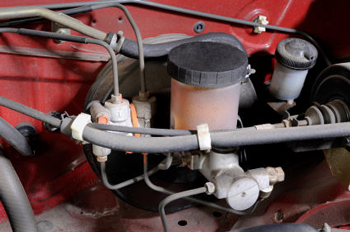 |
|
Please note: This summary is provided to help you understand the regulations. Consult the references provided for links to the full text of the regulations.
This section covers federal and state regulations regarding used brake fluid. Although most semi-trailer trucks use air brake systems that do not contain fluids, fleets with smaller trucks may have hydraulic breaking systems and will need to contend with regulations covering used brake fluid.
Who is covered by the regulations? There are some exceptions, but most transportation facilities that generate brake fluid and used oil as a result of vehicle or machine maintenance are regulated as used oil generators and must comply with the applicable federal and state regulations. The used oil rules apply to nearly any of the petroleum based or synthetic substances that are used for lubrication, heat transfer, or hydraulic fluid. If you have any questions on what is and what is not considered used oil, check out EPA's guidance table. What is the purpose of the regulations? Brake fluid and other used oils are regulated because they contain harmful contaminants, such as brake cleaning solvent. The regulations require safe management and disposal of used oil, which protects not just drinking water, fish, and land, but also the workers in your shop. Also, federal and state used oil regulations encourage oil recycling, which conserves a valuable non-renewable resource. In 1987, EPA issued a memorandum that defined "used oil" to include brake fluid, power steering fluid, and automatic transmission fluid (see Marcia E. Williams memorandum). Therefore, the used oil regulations apply to used brake fluid that is recycled as used oil (see TERC Used Oil section). On the other hand, if used brake fluid is going to be disposed of, then it is not regulated under the used oil standards, but rather, it is regulated like other potentially hazardous wastes (e.g., the generator must make a hazardous waste determination). For more information on hazardous was rules, see the TERC Hazardous Waste section. Also, it is important to note that if used brake fluid is mixed with a listed hazardous waste (e.g., spent solvent) or if it contains more than 1,000 parts per million (ppm) total halogens, then it is a hazardous waste and must be managed as such. Most states have adopted the federal management standards for used oil, which includes used brake fluid. However, some states use slightly different definitions of used oil or have additional rules that may apply to your facility. For state-specific information, see the TERC Used Oil section. In most states, used brake fluid that is not contaminated with solvent can be combined with used oil and recycled. However, check with your local used-oil recycler to determine if it's allowed and the acceptable amounts. Also, see TERC Used Oil section for additional information. See TERC Used Oil section. 40 CFR Part 279 - Standards for the Management of Used Oil Managing Used Oil: Advice for Small Businesses - EPA fact sheet.
|
 Brake Fluid
Brake Fluid